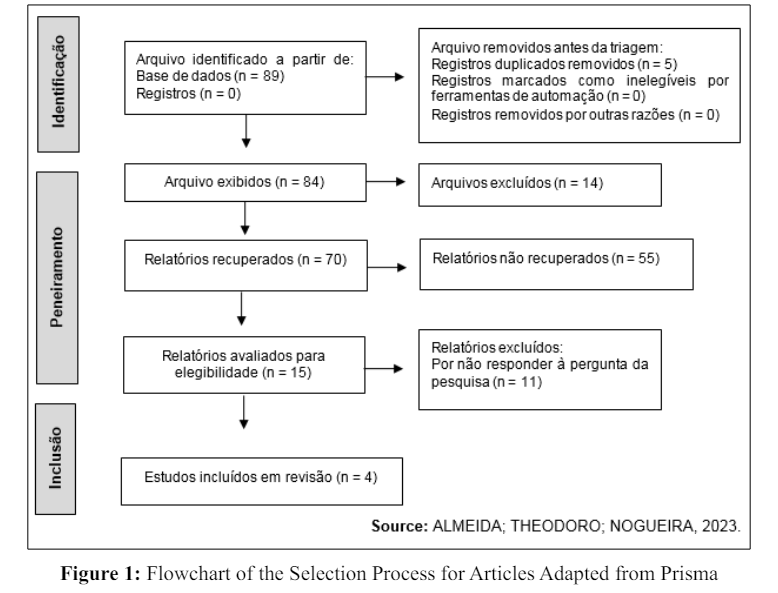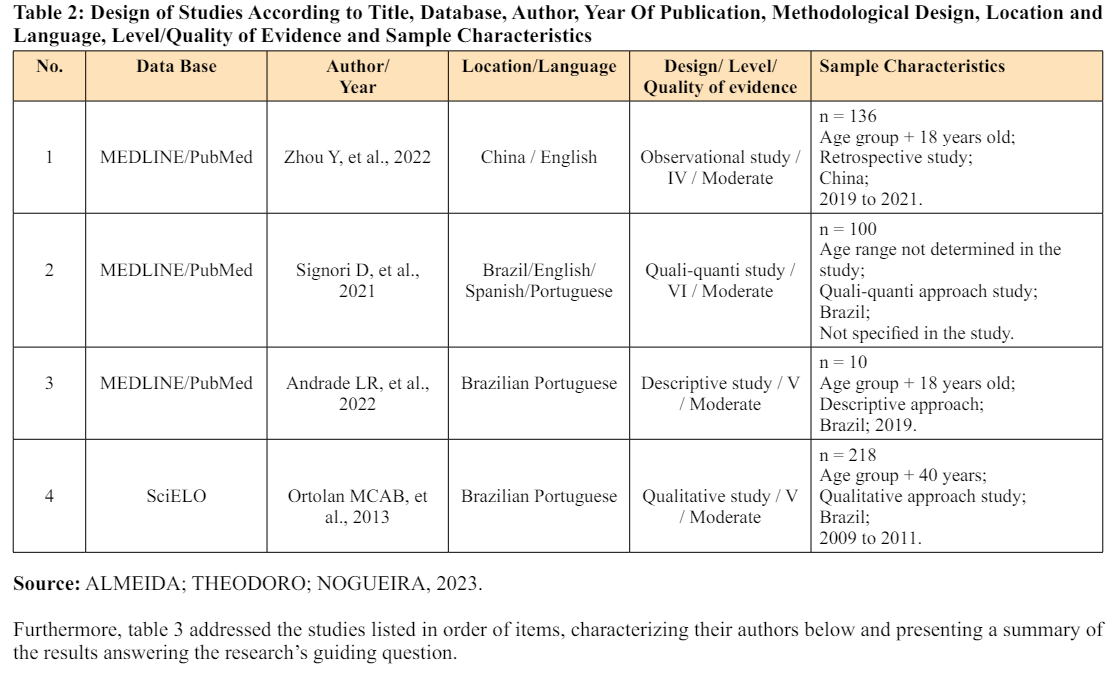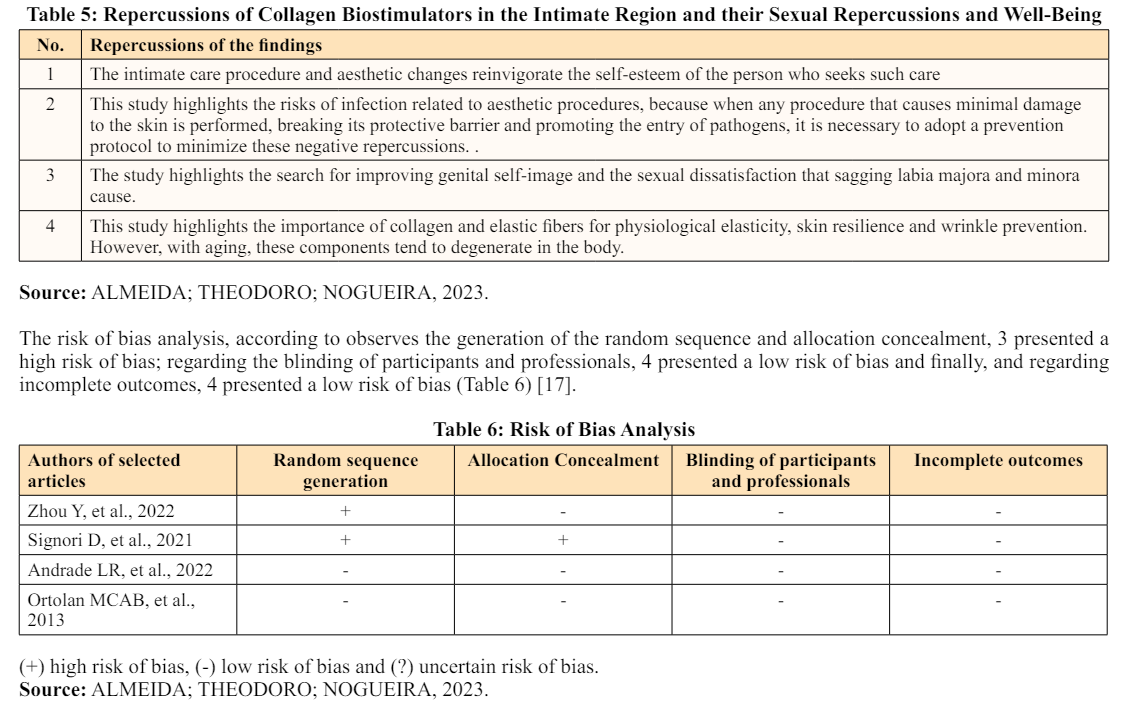Author(s): Viviane Leandro Almeida*, Mirele Renata Fadel de Morais Teodoro and Patrícia Leite Nogueira
Objective: To investigate in the literature the importance of collagen biostimulators in the female intimate region and their repercussions for women’s sexual health and well-being.
Methods: This is an integrative literature review. The PICo strategy was applied: P: Women; I: Care of the intimate area; Co: Applicability of collagen biostimulators. Also, the following databases were used: Embase, Medical Literature Analysis and Retrieval System Online, SCOPUS, Web of Science, and the Scientific Electronic Library Online virtual library.
Results: n = 89 studies were found, which were selected after a thorough investigation of n = 4 articles. Final considerations: This research aimed to provide more information about the importance of collagen biostimulators in the female intimate region and its repercussions for women’s sexual health and well-being, facilitating the understanding of the topic addressed due to the lack of studies
The demand for aesthetic treatments has increased worldwide in recent years, especially when associated with rejuvenation and well-being. Among the body areas that have gained greater prominence is the female genitalia, adhering to procedures that include changes, mainly, in the labia minora and majora, related to size, symmetry, firmness and the presence of wrinkles [1,2].
Thus, intimate aesthetic surgery has been gaining prominence, especially in Brazil. This country holds the first place in the ranking of labiaplasty, even surpassing the United States. Through today’s modern society, which frequently exposes new ways of making changes to one’s own body, this procedure is seen as a way of adhering to an aesthetic standard that reduces self-criticism, as that anatomical changes can sometimes bring discomfort and interfere with a woman’s well-being [3].
In recent decades, the use of collagen as a biomaterial in human patients has stood out, mainly in the context of aesthetics, and it comprises around 70% of the composition of the dermis, a protein of extreme relevance to humans. Its loss directly reflects the sagging and loss of volume, especially in the intimate region, where there is a greater disappearance in the volume of the labia majora or even the growth of the labia minora. It is important to highlight that its presence is related to the firmness and flexibility of the skin’s elastic fibers, which is why there is a great search for related procedures. However, with advancing age collagen tends to change both qualitatively and quantitatively [4]
Increasing age is proportional to the decrease in collagen density, but its causes are not yet fully understood. That is, aging is relative, it does not follow the same pattern in different individuals, being related to lifestyle habits, pre-existing diseases, genetic factors and environmental influences. However, elderly people’s fibroblasts continue to produce collagen, which may suggest that their decrease would be subject to increased degradation, as with aging there is also an increase in matrix metalloproteinases, which degrade collagen [5].
The labia majora and minora undergo changes due to the production of collagen, which can lead to genital flaccidity. This directly impacts the sexual dissatisfaction of many people with a uterus and vulva, as negative genital self-image can directly interfere with their performance and sexual life. Therefore, in order to reduce these effects, it is ideal to stimulate the production of collagen and elastin, in order to improve skin sagging and consequently the aesthetics of the labia minora and majora [6].
In this way, we can see the negative impacts that the reduction of collagen brings to a woman’s sexual life, often restricting her sexual pleasure and performance, due to self-criticism of her own body. Therefore, this study seeks to investigate in the literature the importance of collagen biostimulators in the female intimate region and their repercussions for women’s sexual health and well-being.
The study is an integrative review. This research has a timeless delimitation, having in its methodological path the following phases: 1) aims to formulate the guiding question and discriminate the objective of the proposed study; 2) the eligibility criteria for the studies that will be included were outlined; 3) searched online databases and virtual libraries in order to find studies that could be included in the research; 4) focuses on analyzing and classifying findings in the literature; 5) analysis of findings in the literature that can be included as base material; 6) finally, the studies selected to compose the review were weighed [7,8].
Subsequently, the guiding question was formulated, followed by the PICo strategy (P: People with uterus and vulva; I: Care of the intimate region; Co: Applicability of collagen biostimulators) [9]. Next, the guiding question was deliberated: What is the importance of collagen biostimulators in the female intimate region and their impact on the sexual health and their well-being
Then, in the selection process, intelligibility criteria were defined, as follows: works that have in their title segment or summary collagen biostimulators in the female intimate region, be original research, available to read the full text in full in the languages English, Spanish and Portuguese, answer the study objective and guiding question, as well as establish the search delimitation with timeless delimitation. Furthermore, during the analysis, studies were found between the years 2002 and 2023, which enabled greater evidence in the scientific development of the focus theme and expansion of the search radius due to the scarcity of studies that met the researchers’ criteria of interest.
It is essential to emphasize that there was no inclusion of studies delimited as gray literature, including the classifications: review studies, theses and dissertations of any type, editorials, books, book chapters, experience reports, as well as studies that do not answered the guiding question and proposed objective. Furthermore, this study has a double-blind analysis, where it is carried out by different, autonomous researchers and lasted from March to May in the year 2023, in addition, online databases were used: Embase, Medical Literature Analysis and Retrieval System Online (MEDLINE), SCOPUS, Web of Science (WoS), and the Scientific Electronic Library Online (SciELO) virtual library.
Further on, it is worth highlighting that the analysis of this study took place rigorously on the chosen articles, leading to an investigation in a qualitative format and which promotes a better understanding of the target topic. This evaluation is divided into 2 distinct categories, namely: The effects of collagen in the intimate region and its relationship with aging; and The repercussions of aesthetic treatments in the intimate region for the self-acceptance.
Furthermore, the entire means of investigation came from studies chosen to compose the scientific path of this study. To this end, as a method of better exemplifying the instructions of the Preferred Reporting Items for Systematic Reviews and Meta-Analyses (PRISMA) a flowchart was created that breaks down the selection of these findings [10].

In accordance with, the process of separating the studies was carried out by two autonomous researchers, during the entire process there was no disagreement or controversy between them. Subsequently, duplicate studies were eliminated, which were used to separate the base data and references by Zotero [11]. Furthermore, the software was used Rayyan® to identify and consult the title and abstracts of articles selected by peers, from which the eligibility criteria are verified [12]. Later, the reading of n=4 studies that were included in this review was formalized (Figure 1).
Furthermore, the degree and design of evidence was analyzed, using the 7-step methodological interpretation of the Agency for Healthcare Research and Quality (AHRQ) : I - includes meta-analysis studies and systematic reviews of randomized and controlled clinical trials; II - well-controlled randomized clinical trial studies are included; III - fits clinical trials with good delimitation and without randomization; IV - the modular, observational and case-control studies outlined are demarcated; V - systematic review, qualitative and/or descriptive studies are included; VI - qualitative and descriptive studies were included; VII - letters intended for expert commissions or opinion of authorities were inserted [13,14].
When thinking about quality criteria and their analysis, the GRADE research system appears to highlight the leveling of studies, being divided into: High level - great confidence in the results of the proposed study; Moderate level - medium tangibility of the results obtained; Low level - results are not indubitable and are limited; Very low level - little certainty in results and limited narrowing [15].
Likewise, the articles included in this review were aligned in a Microsoft® Excel format table with the following main information to guide the study: database, author and year of publication, location and language, methodological design, level and quality of evidence, enabling an improved visualization of the findings, as shown in table 2. The investigation started from a broad and structured reading in stages so that the exemplification of a flowchart with indications from PRISM A could better be constructed [10].
During the course of the research, 89 studies were found from which, at the end of the selection process, n = 4 articles were selected. Next, Figure 1 is shown in the steps described, which presents the PRISMA sequence carried out in this study.

Subsequently, in table 2, the inclusion of the basis for the design of this study was established, containing the following information: database, authorship, year of publication, location and language, methodological design, level of evidence, quality of evidence, and characteristics of the sample such as: number, age group, instrument, location and period of study. Likewise, when analyzing the material further, we saw the minority of international articles (n = 1), and the dominance of articles published in English, Spanish and Portuguese in recent years of national origin (n = 3). Following this, discuss the definition of the degree of evidence of articles delimiting the dominance of level V, and determines the quality of which these are used as moderate [15,16].



Based on the selected studies, the importance of collagen in the vulva’s region became evident, ensuring their physical and sexual well-being.. Therefore, it is necessary to understand how its effects are related to aging and how anatomical and aesthetic changes in this region affect your self-image. To this end, the topic in question was analyzed, organizationally fragmenting it into 2 categories, namely: The effects of collagen in the intimate region and its relationship with aging; and the repercussions of aesthetic treatments in the intimate region for the self-acceptance of people.
With aging, skin elasticity is limited, resulting in greater fragility, atrophy and loss of collagen and fat. In relation to collagen, it is a fibrous protein that stands out, as its largest quantity is type I collagen, representing around 80%, being present in tendons, bones and skin. Procedures based on collagen are capable of providing visible results, such as elasticity, firmness and support. Furthermore, it is important to emphasize that collagen biostimulators act as a source of local rejuvenation, and their results can be better seen in the long term [18].
The cells responsible for collagen production, fibroblasts, do not stop reproducing with aging, however there is an increase in the enzymes responsible for collagen degradation, matrix metalloproteinases. Furthermore, elastic fibers are responsible for the physiological elasticity present in the skin, which is why their degeneration, together with collagen, leads to its reduction and the formation of wrinkles [5].
and majora, have a high concentration of estrogen hormone receptors. However, in the post-menopause period, due to the loss of this hormone, these people produce a dysfunction known as “Menopausal Genitourinary Syndrome”. Thus, with the drop in hormonal levels, there is also a decrease in some important factors, such as elastic fibers and collagen in the vaginal mucosa, contributing to the loss of elasticity and firmness in the genital area [19].
Based on this, one of the procedures that are used to stimulate collagen production are biostimulators. Its mechanism of action consists of stimulating the production of collagen through fibroblasts, being classified according to duration and absorption in the body, and presenting advantages for being a less invasive and safe technique when compared to aesthetic surgeries [18].
Due to non-invasive facial rejuvenating procedures gaining prominence in the field of aesthetics, the search for procedures involving non-facial areas and their recommendations arose, aiming to provide well-being and safety. With this, we adopted the use of Radiesse, a biostimulator that allows both volume replacement and the stimulation of collagen formation, which is biocompatible, biodegradable and reabsorbable [20].
In this match, the most common biostimulators in the intimate region are Poly-L-Lactic Acid (PLLA) and Calcium Hydroxyapatite (CaHA). Raidesse, also known as CaHA, is a substance for application in soft tissues, which when used in a periosteal plane, is capable of acting as a liquid implant in the fat compartments, supporting overlapping tissues. Furthermore, due to its high viscosity, it is able to remain stable and not move after application [21]. In this match, the most common biostimulators in the intimate region are Poly-L-Lactic Acid (PLLA) and Calcium Hydroxyapatite (CaHA). Raidesse, also known as CaHA, is a substance for application in soft tissues, which when used in a periosteal plane, is capable of acting as a liquid implant in the fat compartments, supporting overlapping tissues. Furthermore, due to its high viscosity, it is able to remain stable and not move after application [21].region, has as its main target by the Food and Drug Administration (FDA) the purpose of stimulating lipoatrophy related to the human immunodeficiency virus (HIV), and was approved in the United States in 2009. This polymer with a gradual effect is used as an injectable, with particles measuring 40 to 63 micrometers in diameter. Its response to the body is inflammatory, followed by the resistance targeted by consumers of this product as a means of skin rejuvenation, which is the stimulation of fibroblasts and collagen I [21].
It is undeniable how modern society still dictates its perceptions and opinions about in the vulva’s region, what is considered beautiful and pleasant, causing them to seek procedures, surgical or not, to improve the aesthetics of their body. One of the body areas that stood out in recent years was the intimate region, where it can be seen that, often, the change is not linked to an abnormality, but simply an aesthetic issue, to make the vagina more symmetrical, the genital lips smaller and less flaccid [3].
According to a study by dissatisfaction with the appearance of one’s genitalia had a negative impact on the social life of the majority of people who underwent the procedure, with these effects being related to self-esteem and sexual attractiveness [6]. However, it can also be seen that no matter how much people suffer the pressures imposed by society, the desire to operate or adhere to certain procedures often comes from them, aiming to feel better [3].
Another factor worth highlighting is the perception of sexuality in old age and how aging conditions interfere with self-acceptance of your body, as the degeneration of elastic fibers and collagen contribute to skin lacking elasticity and support. Therefore, mainly the intimate region suffers the effects of the low levels of these components, making these people feel dissatisfied with the appearance of their genitalia, causing harm to their sexual life [5,6].
However, one of the problems still evident is that there is a prejudice in approaching sexual, especially when they experience old age. However, sexual activity should not be limited in old age, but encouraged, as it promotes several health benefits, including increased well-being and self-esteem. Therefore, it is essential that these women do not feel ashamed of their own bodies or that this limits their sexual practice, and the stigmas imposed by society must always be broken [22].
It is essential to highlight this because, as already mentioned, sexuality is an activity that contributes positively to the quality of life of elderly people, related to the search for well-being, pleasure and self-esteem. Even though it is a vital function, there is a correlation between several factors, such as biological, psychosocial and cultural. However, even in the care field, the issue of elderly people’s sexuality was often neglected by health professionals and public authorities, generating impacts on the health of this population in several aspects [23].
Furthermore, the search for ideal beauty standards has intensified for decades and the vulva’s region has been the target of aesthetic interventions, with a utopian idea that the objective is always to seek well-being. However, the standards imposed can impact their self-acceptance, the way they see themselves, often becoming incapable of feeling pleasure during sexual intercourse just because their self-esteem is shaken, especially elderly people,who suffer with the imposition of society and the frequent attempt to disconnect their image from pleasure [22,24].
After analyzing the findings, it was seen that the information on collagen biostimulators in the vulva’s region is almost scarce. It is necessary to develop more in-depth studies on this topic, which is essential so that there are broader means of information in care planning and better coverage of the needs of people who undergo this procedure. Therefore, greater benefits can be offered to the treatment of these customers/users. This research aims to provide more information about the importance of collagen biostimulators in the vulva’s region and its repercussions on sexual health and well-being, facilitating the understanding of the topic addressed.
